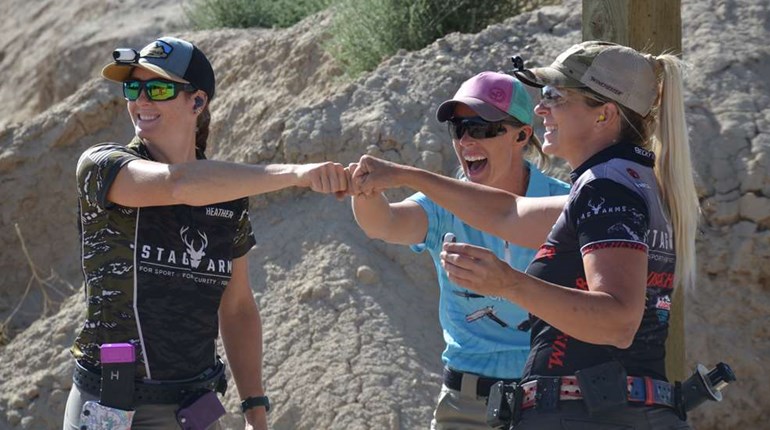
We've all got lots of reasons to teach someone to shoot. Whether we're introducing an adult friend or relative to the world of gun safety or teaching our own children, we should always remember that there's quite a lot to learn...and that newbies can and do make mistakes. When teaching your protégé to shoot, gun safety should be the primary concern. Marksmanship comes later. Of course you should instill the NRA’s basic gun safety rules into any novice, but when transgressions occur it’s up to you how to best correct them. Here are tips for three commonly broken gun safety rules that you can help nip in the bud.
1. Pointing a firearm at in an unsafe direction:
NRA Gun Safety Rule No. 1 says “Always keep the gun pointed in a safe direction.” But sometimes determining a safe direction isn’t so easy if the new shooter does not understand the power and range of a bullet. But anyone, even kids, can easily learn.
First, explain that bullets do not always simply stop or fall harmlessly to the ground after they strike their target. Say something bold like, “This .22 can go right through that wall and hurt whatever is on the other side.” Then, if possible on your range, place a soda bottle on the other side of a thin plywood board and shoot it. This demonstrates the power of the gun and proves that bullets do not stop at the first object they hit. It illustrates that shooters must think in three dimensions, and that they must not only know what their target is, but what the backstop is made of and what lies beyond it.
They should be told that a .22 rifle bullet can travel for a mile or more when aimed at an angle (and a centerfire rifle bullet can travel several miles). Then you should actually give them an idea of how far that is by pointing at an object in the distance. They should know that any damage their bullet causes—even if a complete accident—is their responsibility and could be life-changing.
Next, explain the concept of ricochet by throwing a tennis ball against a wall. Throw it hard so it gets their attention. They should know to never shoot at anything harder than their bullet at close ranges—such as steel plates or rocks—and that a bullet shot at a slight angle at a pond will almost certainly skip on the water and continue on a new path far into the distance. An easy demonstration of this is to skip a rock on the water. Combined with their newfound knowledge of how powerful the bullet is, most people will quickly gain respect for guns. Building on these demonstrations, new shooters should be taught to think three-dimensionally when considering a safe direction.
From different places in your home, garage, porch, in your yard and at the range, ask your protégé to point to the safest direction. Then ask him or her to explain why. In a two-story home, for example, explain that pointing the gun up is not a safe direction while standing on the ground floor. Explain that to point the gun down is unsafe while on the second floor. (Your protégé will recall the board-penetration demonstration.)
While outside, explain that holding the gun down is best while on grass or dirt; and that up is usually safe provided there are no houses in the distance. But holding a gun down while on concrete may not be safe due to ricochet. Be absolutely honest in terms of what a bullet can penetrate and what it can’t. For example, a pond dam is good. A piece of plywood is not. With practice, your protégé will be able to reasonably deduce the safest direction in most scenarios.
2. Shooting Without Eye Protection
Shooting without safety glasses is foolish and shouldn’t be tolerated. Even BB guns can be dangerous to the eyes. This is because BBs are made of steel, so they do not deform and lose much of their energy upon striking a target like lead bullets will. And due to their modest velocity they tend to ricochet rather than penetrate. And while they won’t often do serious harm to the body, they have enough energy to wreck the delicate tissue of the eye.
In my view, any person who shoots a gun should never shoot without ANSI z87-rated polycarbonate shooting glasses. So how do you ensure that your protégé will always wear them, even when you're not around?
First, set an example. If you aren’t wearing shooting glasses, your mentee may begin to suspect that it's not a hard-and-fast rule. Conversely, if everyone wears eye protection as they should, your charge will want to be a part of the club. Secondly, make sure your new shooter has her or his own set of shooting glasses. Put her name on them or let him pick the style and color. Make this become part of their routine shooting gear, just like ammo. If they forget it, you won't let them shoot. Sacrificing one day at the range may be worth this valuable lesson.
3. Placing the Finger Prematurely on the Trigger
Most people are seemingly born with the knowledge of what a trigger is and which finger is used to pull it. Therefore, they often pick up a gun and instinctively place their finger on the trigger before they are ready to actually shoot. This must be sternly corrected by reminding the new shooter each time he or she transgresses. Demonstrate how to put his or her finger alongside the trigger guard, just like you do.
Next explain that the gun’s safety is a mechanical device that can fail—and so one's finger and brain are the ultimate gun safety devices—but also insist that he or she always use the gun’s safety. The safety should be moved to the fire position as the gun is being mounted. This takes some practice, but once it is learned it becomes second nature and in no way inhibits the mount, swing, speed or accuracy of the shot.
Never let your student hand you a gun, put a gun down, reload it, etc., without first making sure he has returned the safety to its safe position. Pretty soon your protégé will likely be correcting you on your transgressions!







































